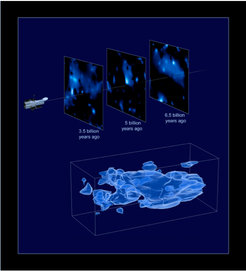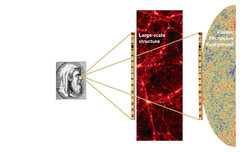Project Description
The most important questions of modern cosmology can be simplified as follows: What are the initial conditions of the universe? What is the nature of gravity? How arises the cosmic acceleration and what is the origin of dark energy and dark matter?
Euclid is predestined to address these questions in great detail by exact analysis of the observed signatures in geometry and within the cosmic structure. Euclid is going to map a large scale area of structure formation over the time span of 10 billion years, i.e. more than 75% of the age of the universe. The mission is optimized for two independent primary cosmological investigations:
(1.) weak gravitational lensing (WL):

The basic idea of weak lensing is the distortion of the path of light from a given background source to the observer in the presence of mass along the way (see also Fig. 1). The image of the background object becomes magnified and stretched towards the foreground mass, which is described by the so-called convergence and shear terms, respectively. Assuming that galaxies have no preferred orientation in space, the statistical estimate of the alignment of the background objects is due to lensing by the foreground object and allows to measure its mass. By using background galaxies of different redshift - thus distance - we are able to move the background wallpaper gradually out in space and map the mass distribution in space along the distance axis. Instrumental and atmospheric effects however, cause a smearing of the observed images. Inevitably, the corresponding point spread function (PSF) must be corrected for accordingly. For example, the spatial variability of the PSF ellipticity over a field of view (FoV) of 50 arcmin2 has to be below 10-4.
(2.) baryonic acoustic oscillations (BAOs):

BAOs can be understood as an invariant length scale imprinted at the early phases of the universe and still notable in the irradiating matter recorded today (see Fig. 2). At such early times, the universe was filled by a hot plasma, where photons and baryons (i.e. protons and neutrons) were still coupled. The underlying density fluctuations resulted in overdense regions, where matter gravitationally clustered thereby increasing the pressure counteracting this gravitational pull. This resulted in oscillations within the plasma in a similar way like sound waves originate from pressure differences in the air. The corresponding sound horizon is an certain length scale and can be used to study cosmology. For example, in the cosmic microwave background maps that represent the era of the decoupling of matter and radiation this typical length scale is imprinted in the radiation background. Looking at the large scale matter distribution in the universe at different epochs (redshifts) one can trace the evolution of this typical length scale through time and space. The requirements driven by the BAOs science case are for example survey depth and the spectroscopic accuracy in determining galaxy redshifts.
Euclid Mission:
The Euclid observations cover 15.000 deg2 of the extragalactic sky and are complemented by two 20 deg2 deep field observations. For the weak lensing investigations Euclid will provide measurements of the form of 30 high resolved galaxies per arcmin2 in R+I+Z-band (550-920nm). They are obtained from the NIR-bands (Y, J, H in the range 0.92-2.0 micrometer). Additional data sets are provided by earth-bound observations such as DES, KiDS and Pan-STARRS.
The BAOs are determined via spectroscopic observations with a redshift accuracy of ≤0.001. The spectrometer mainly observes H-alpha galaxies. The limitated flux corresponds to 3·10-16 erg s-1 cm-2, which results in over 50 million galaxy redshifts with a completeness larger than 45%.
The deep survey is two magnitudes deeper with respect to the wide survey. This is required for the spectroscopic calibration and is inimitable.
Euclid will be launched in 2020 using a Soyuz ST-2.1B-rocket. It will take ~30 days to reach the second Lagrange point of the earth-sun system, where it will in total observe six years to achieve all planned measurements. The corresponding data processing and calibration will take additional 3-6 months. The image quality is guaranteed with observations of the sky using circles with constant solar angles. Possible variations of angles between different fields are limited to a maximum of 5 deg, to allow for the best thermal stability. The scientific data of the satellite will be received and processed with a rate of 850 Gbit/day by several ground stations.
MPE Contribution:
The Max Planck Institute for Extraterrestrial Physics (MPE) is responsible for the overall optical design of the near-infrared instrument, in particular it procures all lenses and their mounts and performs the corresponding functionality tests. In addition to the hardware development, MPE is involved in the scientific data processing of the mission. LMU is co-leading the preparation of ground-based complementary data and their merging with the Euclid visual and infrared data. Both institutes are represented in several science working groups, in the Euclid Consortium Board and the ESA Science Team.

